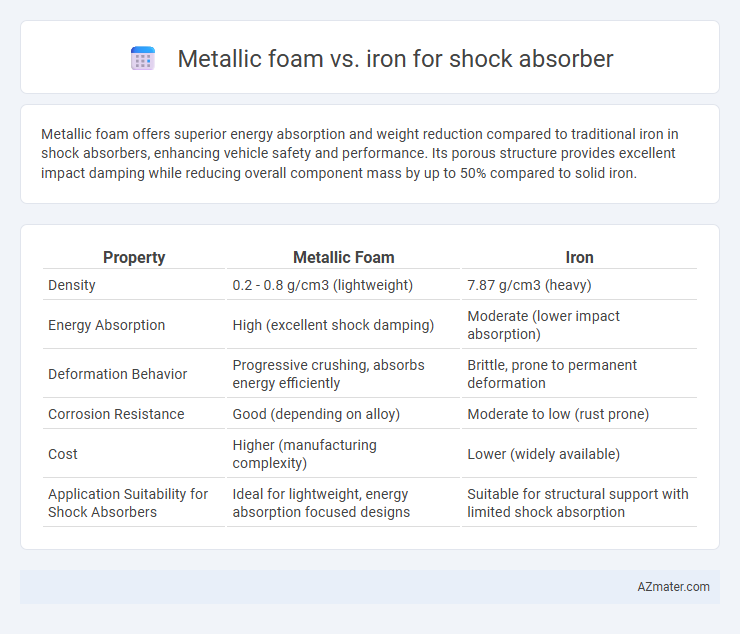Metallic foam offers superior energy absorption and weight reduction compared to traditional iron in shock absorbers, enhancing vehicle safety and performance. Its porous structure provides excellent impact damping while reducing overall component mass by up to 50% compared to solid iron.
Table of Comparison
| Property | Metallic Foam | Iron |
|---|---|---|
| Density | 0.2 - 0.8 g/cm3 (lightweight) | 7.87 g/cm3 (heavy) |
| Energy Absorption | High (excellent shock damping) | Moderate (lower impact absorption) |
| Deformation Behavior | Progressive crushing, absorbs energy efficiently | Brittle, prone to permanent deformation |
| Corrosion Resistance | Good (depending on alloy) | Moderate to low (rust prone) |
| Cost | Higher (manufacturing complexity) | Lower (widely available) |
| Application Suitability for Shock Absorbers | Ideal for lightweight, energy absorption focused designs | Suitable for structural support with limited shock absorption |
Introduction to Shock Absorbers: Why Material Matters
Shock absorbers rely heavily on material properties to efficiently dissipate energy and reduce vibrations during dynamic impacts. Metallic foam, with its lightweight structure and high energy absorption capacity, offers superior damping characteristics compared to traditional iron-based shock absorbers, which provide greater stiffness but less effective impact energy dispersion. Choosing between metallic foam and iron hinges on balancing weight reduction with durability and performance efficiency in shock absorption systems.
Understanding Metallic Foam: Structure and Properties
Metallic foam exhibits a unique cellular structure characterized by a high volume of interconnected pores, resulting in low density and exceptional energy absorption capabilities. This porous architecture allows metallic foam to dissipate impact forces efficiently, making it an ideal material for shock absorbers compared to traditional solid iron. The combination of lightweight properties and high compressive strength enables metallic foam to provide superior cushioning and vibration damping in automotive and industrial applications.
Traditional Iron: Strengths and Limitations
Traditional iron offers high compressive strength and durability, making it effective for shock absorber components subjected to heavy loads. Its density and rigidity provide reliable energy absorption but result in greater weight, limiting overall vehicle efficiency. Iron's susceptibility to corrosion and fatigue over time can reduce performance, necessitating regular maintenance or protective coatings.
Weight Comparison: Metallic Foam vs Iron
Metallic foam offers a significant weight advantage over traditional iron in shock absorber applications, with densities typically ranging from 0.4 to 1.0 g/cm3 compared to iron's density of approximately 7.8 g/cm3. This dramatic difference results in metallic foam components that are up to 80-90% lighter, improving vehicle fuel efficiency and handling. The lightweight nature of metallic foam, combined with its energy absorption capabilities, makes it a superior choice for reducing overall suspension system weight while maintaining effective shock absorption.
Energy Absorption Efficiency in Shock Absorbers
Metallic foam offers superior energy absorption efficiency compared to traditional iron in shock absorbers due to its cellular structure that dissipates impact energy more effectively. The porous nature of metallic foam enables better deformation under stress, reducing peak loads and improving crashworthiness. Iron, with its solid and dense composition, lacks this energy-absorbing capability, resulting in less efficient shock absorption and higher transmitted forces.
Impact Resistance: How Metallic Foam Outperforms Iron
Metallic foam exhibits superior impact resistance compared to iron due to its highly porous structure, which efficiently absorbs and dissipates energy upon impact. This unique cellular composition reduces stress concentrations and delays material failure, making metallic foam an ideal choice for shock absorber applications. In contrast, solid iron, despite its high strength, lacks the energy absorption capacity inherent to metallic foam, resulting in less effective impact mitigation.
Corrosion Resistance and Durability Factors
Metallic foam exhibits superior corrosion resistance compared to traditional iron, owing to its porous structure that can be engineered with corrosion-resistant alloys and coatings, enhancing longevity in harsh environments. Iron, while strong, is more susceptible to rust and corrosion over time, which compromises its durability and shock absorption efficiency. The enhanced corrosion resistance of metallic foam translates into longer-lasting shock absorbers with reduced maintenance requirements, making it a more durable choice for applications exposed to moisture and corrosive elements.
Manufacturing and Cost Considerations
Metallic foam offers lightweight properties and energy absorption benefits in shock absorbers, but its manufacturing involves complex processes such as powder metallurgy and foam infiltration, which can increase production costs compared to traditional iron components. Iron, though heavier, benefits from well-established, cost-effective manufacturing techniques like casting and forging, enabling mass production at lower expenses. Choosing between metallic foam and iron depends on balancing superior shock absorption performance with budget constraints and manufacturing capabilities.
Environmental Impact: Sustainability Analysis
Metallic foam exhibits superior environmental sustainability compared to traditional iron in shock absorber applications due to its lightweight structure, which enhances fuel efficiency and reduces carbon emissions during vehicle operation. The production process of metallic foam generally consumes less energy and generates fewer pollutants than iron smelting and casting, minimizing the overall ecological footprint. Furthermore, metallic foam's recyclability and potential for reuse contribute to circular economy initiatives, aligning with green engineering principles and sustainable material management.
Future Trends: Is Metallic Foam the Next Standard?
Metallic foam presents significant advantages over traditional iron in shock absorbers due to its lightweight, high energy absorption, and superior damping properties, making it ideal for reducing vehicle weight and enhancing performance. Advances in manufacturing techniques, such as additive manufacturing and alloy optimization, are driving cost reductions and customization capabilities, positioning metallic foam as a viable alternative in automotive and aerospace applications. Industry trends indicate increasing adoption of metallic foam composites, signaling a potential shift toward this material becoming the future standard in shock absorber technology.

Infographic: Metallic foam vs Iron for Shock absorber
 azmater.com
azmater.com